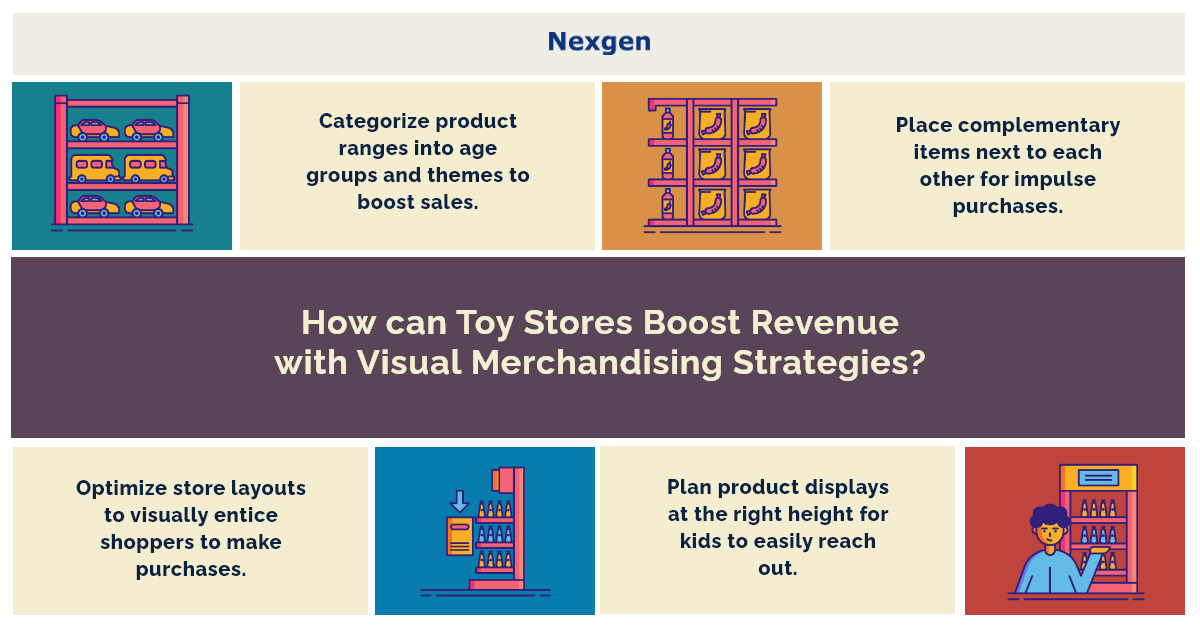Why does the phrase “like a kid in a candy store” sound familiar? It is because everyone understands how a wide-eyed kid will stare at their impending sugar rush. When a child shops at your store, they are not practically thinking like an adult about a product’s price, usage or durability. Bright colors like blue, red, green, pink, yellow and orange may catch their eye and oversized versions of their favorite cartoon character at your store display will draw their attention. Because of this, displaying toys is a different ball game for the retailer, in which you need to plan the store to appeal both to the kids and adults in making their purchasing decisions.
Child-driven purchases make the shopping experience a positive one for everyone, which helps to reduce in-store stress for adults. The new generation of younger shoppers are more demanding than ever, and you need to display toys aesthetically in order to match their emotions, fun, needs, and joy. Some families also proactively give children more importance in purchase decisions. In order to compete in such an environment, you must keep up with ever-changing shopper appetites. One such reason is that if adults want to pick the toys fast for their little ones, they demand quick product availability on your store shelves. That is why the toy business needs highly efficient shelf planning software , to satisfy customer needs with smart replenishing and reordering, and well-enticing displays. Planograms are visual merchandising tools, which help retailers plan and execute their product shelves effectively to boost sales. If you want to sell toys successfully, follow these visual merchandising tips for enticing shoppers.

- Appeal to kids and sell to parents: The biggest purchasing influence for kids in your store are product availability, easy shelving, packaging, and enticing displays. Numerous studies show that bright colors and cartoon characters can attract kid’s attention and chances for impulse buying could be 40% more. Once you successfully grab the kid’s attention, you need to remove barriers to sale for parents. This is something you can do with the product ranges. Categories play a key role in creating an effective product range for toys, including classifying the products by age groups and themes to boost sales. This can be achieved by unintendedly promoting a toy’s benefits and quality. For example, placing play sets, drawing or coloring books from a newly released children’s series or items linked to seasons such as ‘back to school’ can also make parents think about the benefits of such products and the chances of buying are high.
- Plan your toy display perfectly: Eye-level is buy level. So, display your items at the right height so that kids can easily reach out. Kids are more likely to be drawn to eye-catching toys that offer novelty value. They have different variations of eye levels to their age group, so while placing the items as a retailer, you need to identify that first. If you want to stand out in your displays, think about their surroundings. Choosing a different color scheme helps you differentiate your store brands and other displays. Unique toy displays, such as snow or summer-themed displays or car-shaped displays, can set you apart from your competitors.
- Optimize store layouts: It is said that around 40% of items selected during the first quarter of a shopping trip are impulse purchases. It is highly more for kids who have shorter attention spans. That is why you need to position items rightly on shelves. For example, placing premium toys on the first display stands can create enthusiasm in kids, which helps them see. Likewise, complementary items can be displayed together: for example, sketches or crayons can be placed next to coloring books for impulse purchases. Also, moving or changing displays or things around once or twice a month can keep the shopping experience fresh, also helping to figure out what works best in terms of product placement. This encourages shoppers to visit your store and understand what changes are being made in the stores.
Overview of Nexgen POG
Nexgen POG is a robust and user-friendly cloud-based visual merchandising tool. It is designed for quick and efficient planogramming with minimal effort. Planograms can be designed by easily dragging and dropping the products. The multi-device compatibility feature of POG allows you to obtain, share and edit planograms on any device, including your phone. It helps in designing store-specific planograms for increased product visibility and sales.
Get Your Free Trial Now!